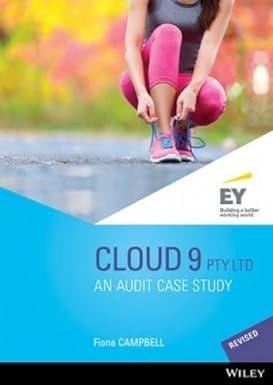Answered step by step
Verified Expert Solution
Question
1 Approved Answer
begin{tabular}{|c|c|l|l|l|l|} hline & & & & & hline & 10 & April 28 & Dividends & & hline & & Cash & &
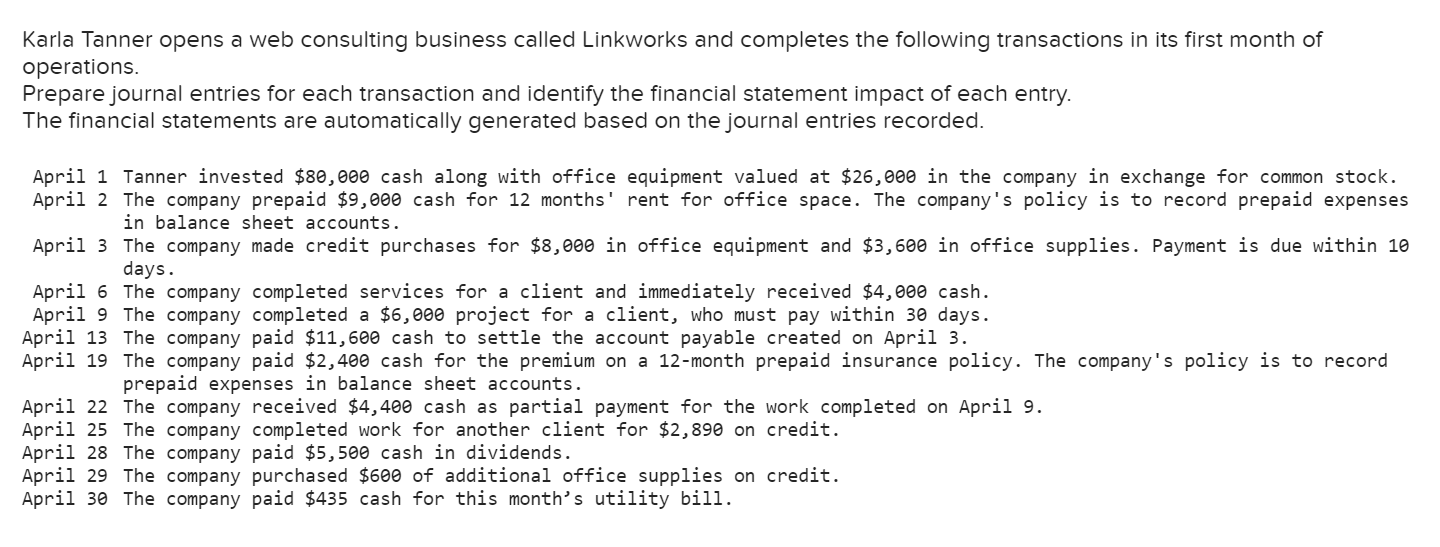
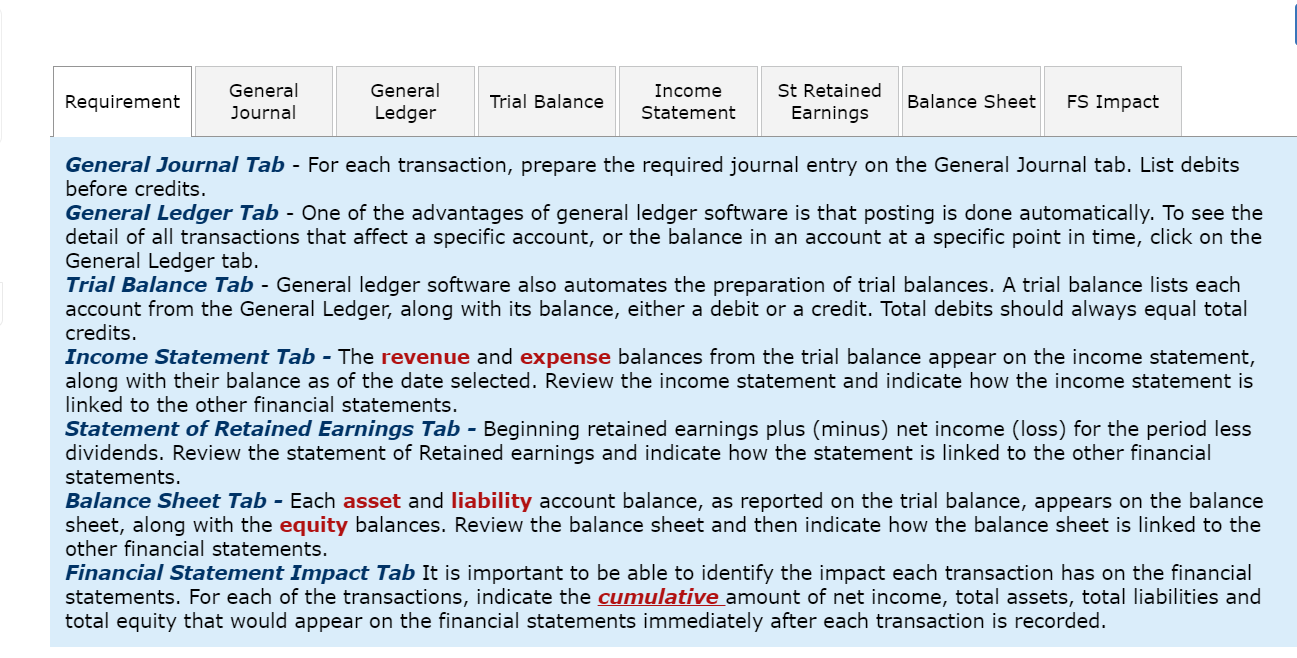
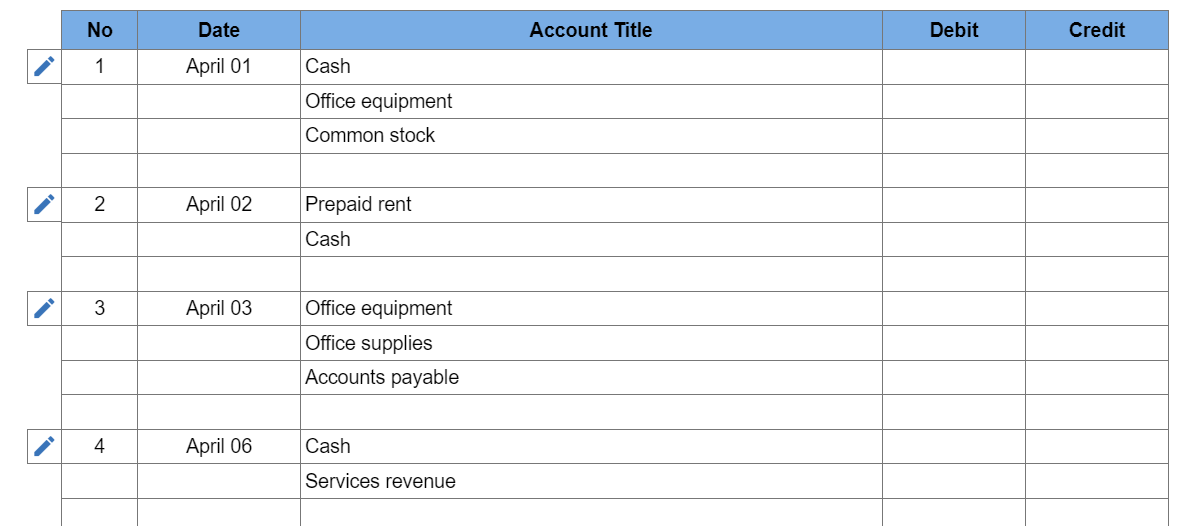
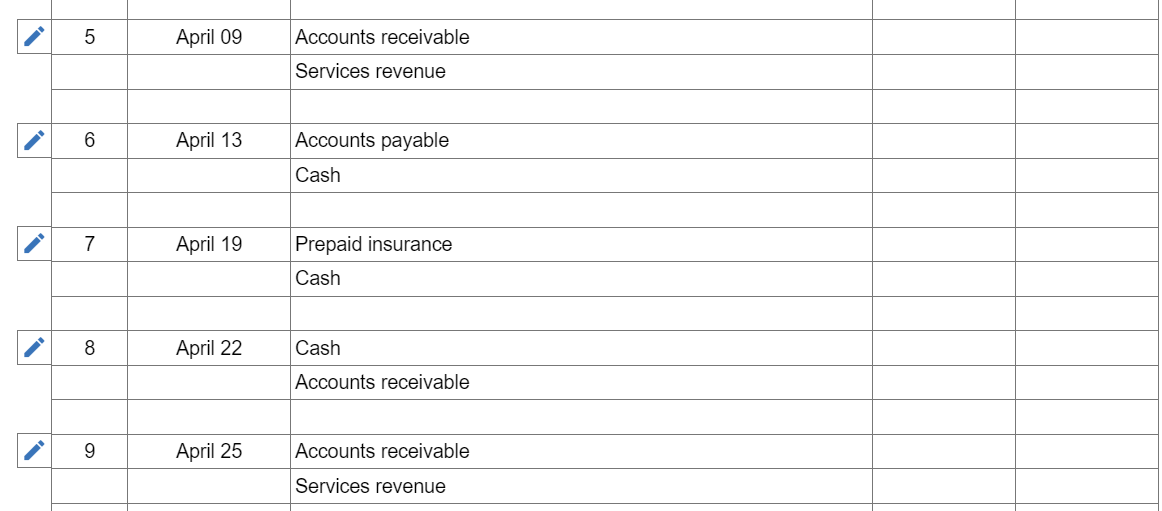

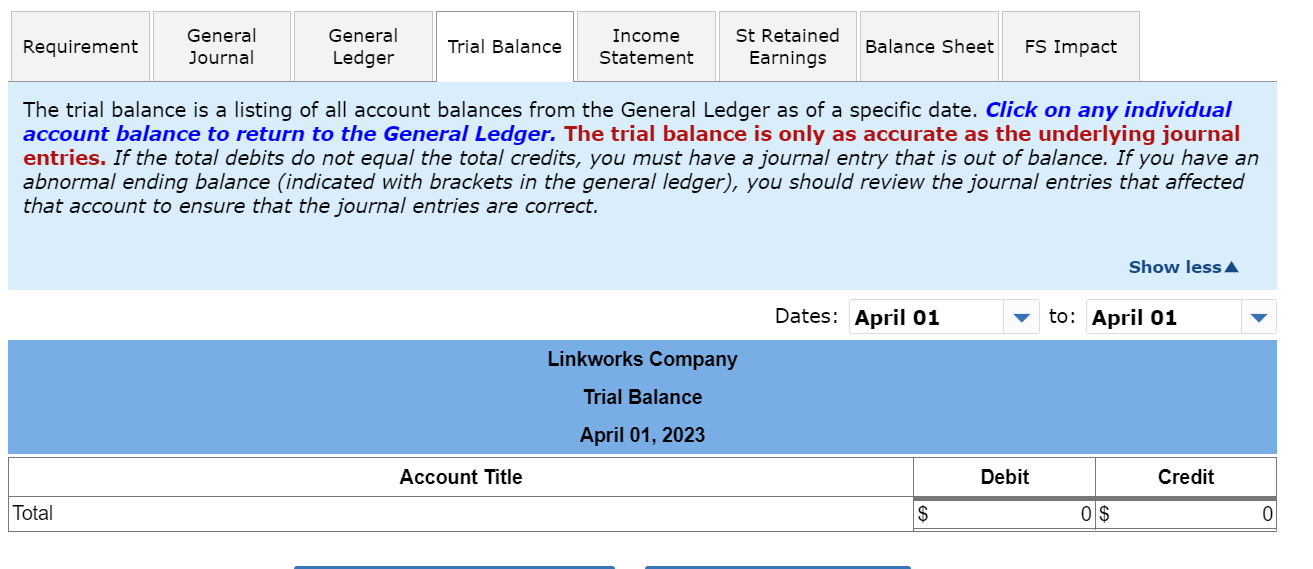
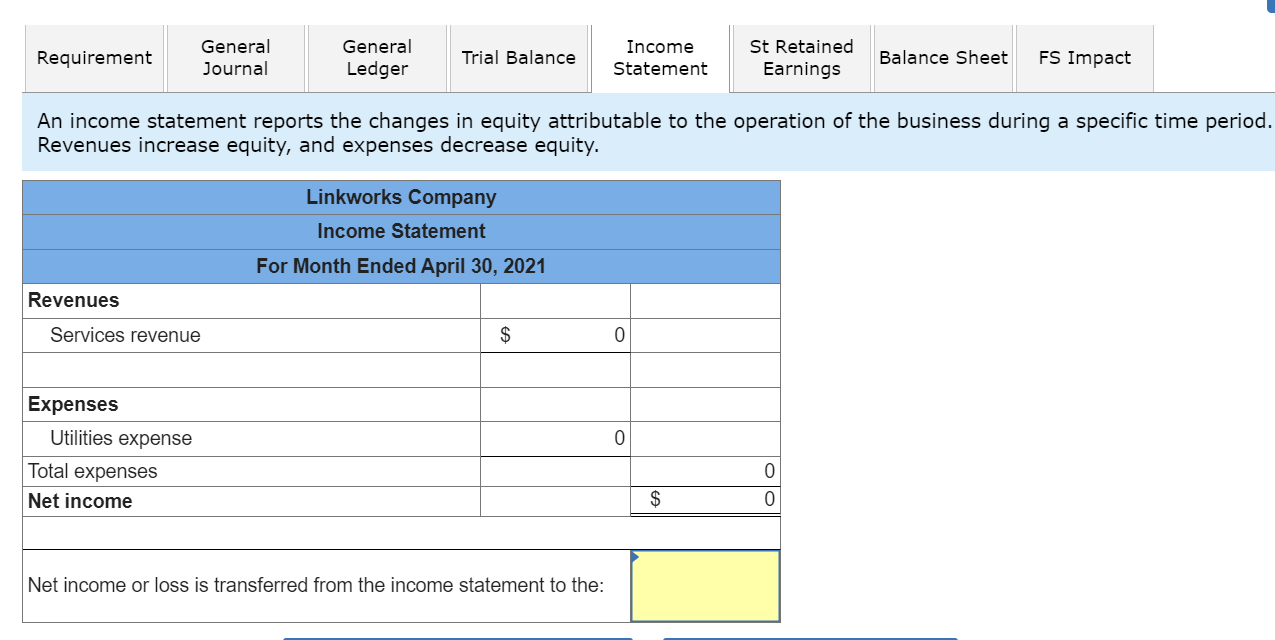
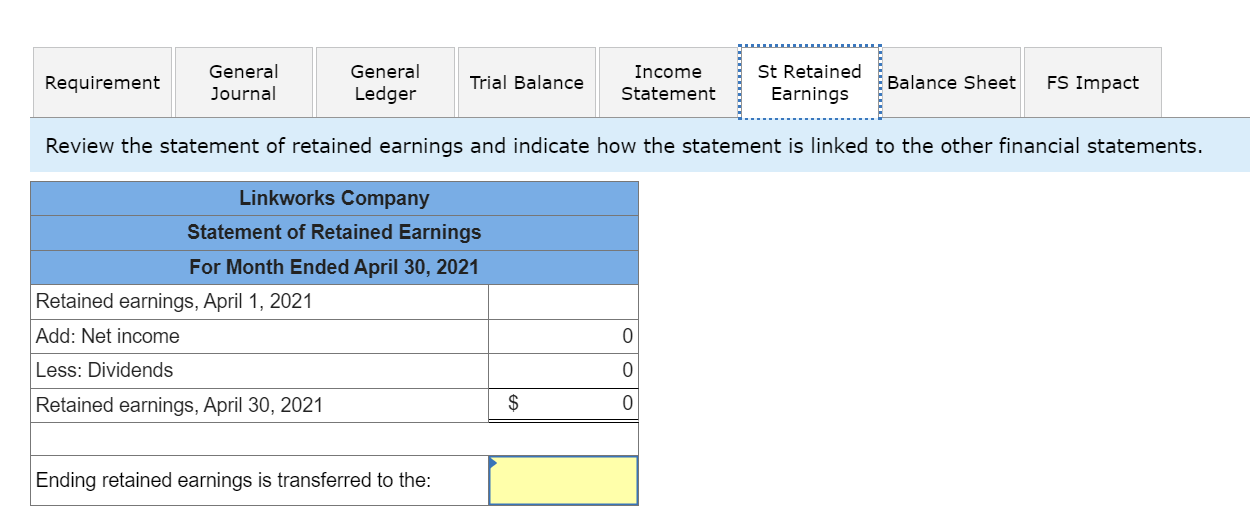
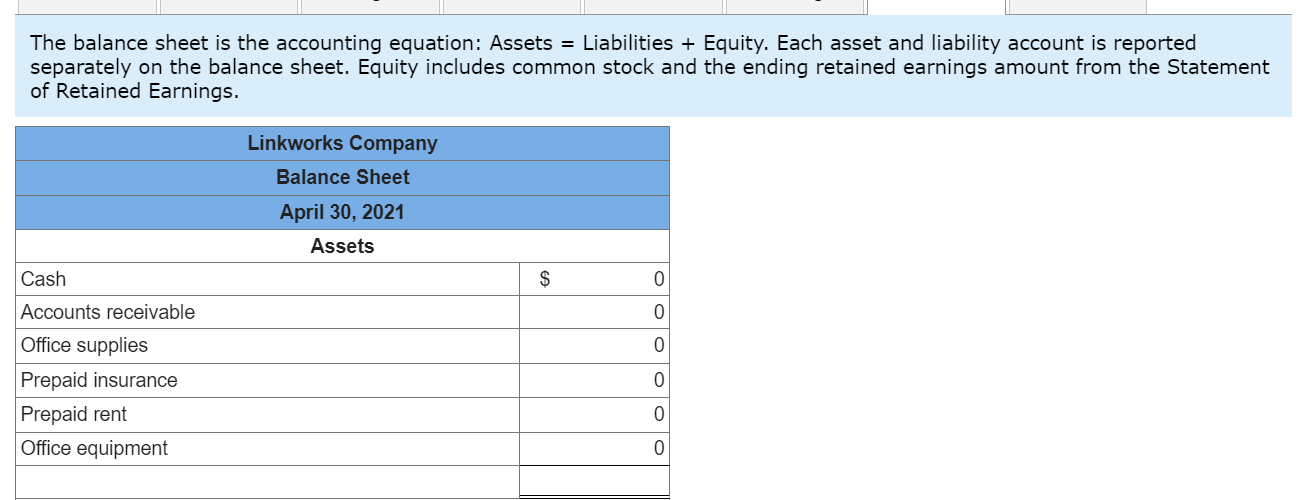

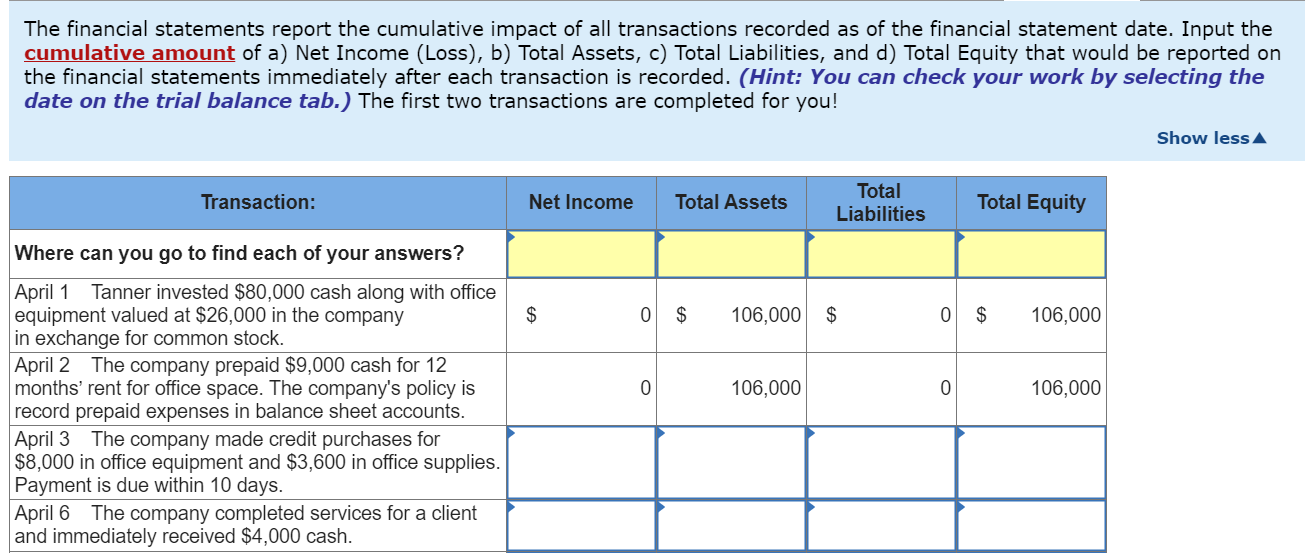
 \begin{tabular}{|c|c|l|l|l|l|} \hline & & & & & \\ \hline & 10 & April 28 & Dividends & & \\ \hline & & Cash & & \\ \hline & 11 & April 29 & Office supplies & & \\ \hline & & Accounts payable & & \\ \hline & & & & \\ \hline & 12 & April 30 & Utilities expense & & \\ \hline \end{tabular} General Journal Tab - For each transaction, prepare the required journal entry on the General Journal tab. List debits before credits. General Ledger Tab - One of the advantages of general ledger software is that posting is done automatically. To see the detail of all transactions that affect a specific account, or the balance in an account at a specific point in time, click on the General Ledger tab. Trial Balance Tab - General ledger software also automates the preparation of trial balances. A trial balance lists each account from the General Ledger, along with its balance, either a debit or a credit. Total debits should always equal total credits. Income Statement Tab - The revenue and expense balances from the trial balance appear on the income statement, along with their balance as of the date selected. Review the income statement and indicate how the income statement is linked to the other financial statements. Statement of Retained Earnings Tab - Beginning retained earnings plus (minus) net income (loss) for the period less dividends. Review the statement of Retained earnings and indicate how the statement is linked to the other financial statements. Balance Sheet Tab - Each asset and liability account balance, as reported on the trial balance, appears on the balance sheet, along with the equity balances. Review the balance sheet and then indicate how the balance sheet is linked to the other financial statements. Financial Statement Impact Tab It is important to be able to identify the impact each transaction has on the financial statements. For each of the transactions, indicate the cumulative amount of net income, total assets, total liabilities and total equity that would appear on the financial statements immediately after each transaction is recorded. \begin{tabular}{|l|r|} \hline \multicolumn{2}{|c|}{ Liabilities } \\ \hline Eccounts payable & $ \\ \hline & \\ \hline Common stock & \\ \hline Retained earnings & \\ \hline & \\ \hline & \\ \hline & \\ \hline The balance in retained earnings comes from the: & \\ \hline \end{tabular} Review the statement of retained earnings and indicate how the statement is linked to the other financial statements. \begin{tabular}{|l|r|} \hline \multicolumn{2}{|c|}{ Linkworks Company } \\ \hline \multicolumn{2}{|c|}{ Statement of Retained Earnings } \\ \hline Retained earnings, April 1, 2021 & 0 \\ \hline Add: Net income & 0 \\ \hline Less: Dividends & \\ \hline Retained earnings, April 30, 2021 & $ \\ \hline \multicolumn{2}{|c|}{} \\ \hline Ending retained earnings is transferred to the: & \\ \hline \end{tabular} An income statement reports the changes in equity attributable to the operation of the business during a specific time perioc Revenues increase equity, and expenses decrease equity. \begin{tabular}{|c|c|l|l|l|l|} \hline 5 & April 09 & Accounts receivable & & \\ \hline & & Services revenue & & \\ \hline & & & & \\ \hline & April 13 & Accounts payable & & \\ \hline & & Cash & & \\ \hline 7 & April 19 & Prepaid insurance & & \\ \hline & & Cash & & \\ \hline & & & & \\ \hline & April 22 & Cash & & \\ \hline & & Accounts receivable & & \\ \hline & & & & \\ \hline \end{tabular} Karla Tanner opens a web consulting business called Linkworks and completes the following transactions in its first month of operations. Prepare journal entries for each transaction and identify the financial statement impact of each entry. The financial statements are automatically generated based on the journal entries recorded. April 1 Tanner invested $80,000 cash along with office equipment valued at $26,000 in the company in exchange for common stock. April 2 The company prepaid $9,000 cash for 12 months' rent for office space. The company's policy is to record prepaid expenses in balance sheet accounts. April 3 The company made credit purchases for $8,000 in office equipment and $3,600 in office supplies. Payment is due within 10 days. April 6 The company completed services for a client and immediately received $4,000 cash. April 9 The company completed a $6,000 project for a client, who must pay within 30 days. April 13 The company paid $11,600 cash to settle the account payable created on April 3 . April 19 The company paid $2,400 cash for the premium on a 12 -month prepaid insurance policy. The company's policy is to record prepaid expenses in balance sheet accounts. April 22 The company received $4,400 cash as partial payment for the work completed on April 9 . April 25 The company completed work for another client for $2,890 on credit. April 28 The company paid $5,500 cash in dividends. April 29 The company purchased $600 of additional office supplies on credit. April 30 The company paid $435 cash for this month's utility bill. The financial statements report the cumulative impact of all transactions recorded as of the financial statement date. Input the cumulative amount of a) Net Income (Loss), b) Total Assets, c) Total Liabilities, and d) Total Equity that would be reported on the financial statements immediately after each transaction is recorded. (Hint: You can check your work by selecting the date on the trial balance tab.) The first two transactions are completed for you! \begin{tabular}{|c|c|l|l|l|} \hline \multicolumn{1}{|c|}{ No } & Date & \multicolumn{1}{|c|}{ Account Title } & Debit & Credit \\ \hline 1 & April 01 & Cash & & \\ \hline & & Office equipment & & \\ \hline & & Common stock & & \\ \hline & & & & \\ \hline & April 02 & Prepaid rent & & \\ \hline & & Cash & & \\ \hline & April 03 & Office equipment & & \\ \hline & & Office supplies & & \\ \hline & & Accounts payable & & \\ \hline & April 06 & Cash & & \\ \hline & & Services revenue & & \\ \hline \end{tabular} The balance sheet is the accounting equation: Assets = Liabilities + Equity. Each asset and liability account is reported separately on the balance sheet. Equity includes common stock and the ending retained earnings amount from the Statement of Retained Earnings. The trial balance is a listing of all account balances from the General Ledger as of a specific date. Click on any individual account balance to return to the General Ledger. The trial balance is only as accurate as the underlying journal entries. If the total debits do not equal the total credits, you must have a journal entry that is out of balance. If you have an abnormal ending balance (indicated with brackets in the general ledger), you should review the journal entries that affected that account to ensure that the journal entries are correct
\begin{tabular}{|c|c|l|l|l|l|} \hline & & & & & \\ \hline & 10 & April 28 & Dividends & & \\ \hline & & Cash & & \\ \hline & 11 & April 29 & Office supplies & & \\ \hline & & Accounts payable & & \\ \hline & & & & \\ \hline & 12 & April 30 & Utilities expense & & \\ \hline \end{tabular} General Journal Tab - For each transaction, prepare the required journal entry on the General Journal tab. List debits before credits. General Ledger Tab - One of the advantages of general ledger software is that posting is done automatically. To see the detail of all transactions that affect a specific account, or the balance in an account at a specific point in time, click on the General Ledger tab. Trial Balance Tab - General ledger software also automates the preparation of trial balances. A trial balance lists each account from the General Ledger, along with its balance, either a debit or a credit. Total debits should always equal total credits. Income Statement Tab - The revenue and expense balances from the trial balance appear on the income statement, along with their balance as of the date selected. Review the income statement and indicate how the income statement is linked to the other financial statements. Statement of Retained Earnings Tab - Beginning retained earnings plus (minus) net income (loss) for the period less dividends. Review the statement of Retained earnings and indicate how the statement is linked to the other financial statements. Balance Sheet Tab - Each asset and liability account balance, as reported on the trial balance, appears on the balance sheet, along with the equity balances. Review the balance sheet and then indicate how the balance sheet is linked to the other financial statements. Financial Statement Impact Tab It is important to be able to identify the impact each transaction has on the financial statements. For each of the transactions, indicate the cumulative amount of net income, total assets, total liabilities and total equity that would appear on the financial statements immediately after each transaction is recorded. \begin{tabular}{|l|r|} \hline \multicolumn{2}{|c|}{ Liabilities } \\ \hline Eccounts payable & $ \\ \hline & \\ \hline Common stock & \\ \hline Retained earnings & \\ \hline & \\ \hline & \\ \hline & \\ \hline The balance in retained earnings comes from the: & \\ \hline \end{tabular} Review the statement of retained earnings and indicate how the statement is linked to the other financial statements. \begin{tabular}{|l|r|} \hline \multicolumn{2}{|c|}{ Linkworks Company } \\ \hline \multicolumn{2}{|c|}{ Statement of Retained Earnings } \\ \hline Retained earnings, April 1, 2021 & 0 \\ \hline Add: Net income & 0 \\ \hline Less: Dividends & \\ \hline Retained earnings, April 30, 2021 & $ \\ \hline \multicolumn{2}{|c|}{} \\ \hline Ending retained earnings is transferred to the: & \\ \hline \end{tabular} An income statement reports the changes in equity attributable to the operation of the business during a specific time perioc Revenues increase equity, and expenses decrease equity. \begin{tabular}{|c|c|l|l|l|l|} \hline 5 & April 09 & Accounts receivable & & \\ \hline & & Services revenue & & \\ \hline & & & & \\ \hline & April 13 & Accounts payable & & \\ \hline & & Cash & & \\ \hline 7 & April 19 & Prepaid insurance & & \\ \hline & & Cash & & \\ \hline & & & & \\ \hline & April 22 & Cash & & \\ \hline & & Accounts receivable & & \\ \hline & & & & \\ \hline \end{tabular} Karla Tanner opens a web consulting business called Linkworks and completes the following transactions in its first month of operations. Prepare journal entries for each transaction and identify the financial statement impact of each entry. The financial statements are automatically generated based on the journal entries recorded. April 1 Tanner invested $80,000 cash along with office equipment valued at $26,000 in the company in exchange for common stock. April 2 The company prepaid $9,000 cash for 12 months' rent for office space. The company's policy is to record prepaid expenses in balance sheet accounts. April 3 The company made credit purchases for $8,000 in office equipment and $3,600 in office supplies. Payment is due within 10 days. April 6 The company completed services for a client and immediately received $4,000 cash. April 9 The company completed a $6,000 project for a client, who must pay within 30 days. April 13 The company paid $11,600 cash to settle the account payable created on April 3 . April 19 The company paid $2,400 cash for the premium on a 12 -month prepaid insurance policy. The company's policy is to record prepaid expenses in balance sheet accounts. April 22 The company received $4,400 cash as partial payment for the work completed on April 9 . April 25 The company completed work for another client for $2,890 on credit. April 28 The company paid $5,500 cash in dividends. April 29 The company purchased $600 of additional office supplies on credit. April 30 The company paid $435 cash for this month's utility bill. The financial statements report the cumulative impact of all transactions recorded as of the financial statement date. Input the cumulative amount of a) Net Income (Loss), b) Total Assets, c) Total Liabilities, and d) Total Equity that would be reported on the financial statements immediately after each transaction is recorded. (Hint: You can check your work by selecting the date on the trial balance tab.) The first two transactions are completed for you! \begin{tabular}{|c|c|l|l|l|} \hline \multicolumn{1}{|c|}{ No } & Date & \multicolumn{1}{|c|}{ Account Title } & Debit & Credit \\ \hline 1 & April 01 & Cash & & \\ \hline & & Office equipment & & \\ \hline & & Common stock & & \\ \hline & & & & \\ \hline & April 02 & Prepaid rent & & \\ \hline & & Cash & & \\ \hline & April 03 & Office equipment & & \\ \hline & & Office supplies & & \\ \hline & & Accounts payable & & \\ \hline & April 06 & Cash & & \\ \hline & & Services revenue & & \\ \hline \end{tabular} The balance sheet is the accounting equation: Assets = Liabilities + Equity. Each asset and liability account is reported separately on the balance sheet. Equity includes common stock and the ending retained earnings amount from the Statement of Retained Earnings. The trial balance is a listing of all account balances from the General Ledger as of a specific date. Click on any individual account balance to return to the General Ledger. The trial balance is only as accurate as the underlying journal entries. If the total debits do not equal the total credits, you must have a journal entry that is out of balance. If you have an abnormal ending balance (indicated with brackets in the general ledger), you should review the journal entries that affected that account to ensure that the journal entries are correct Step by Step Solution
There are 3 Steps involved in it
Step: 1

Get Instant Access to Expert-Tailored Solutions
See step-by-step solutions with expert insights and AI powered tools for academic success
Step: 2

Step: 3

Ace Your Homework with AI
Get the answers you need in no time with our AI-driven, step-by-step assistance
Get Started


